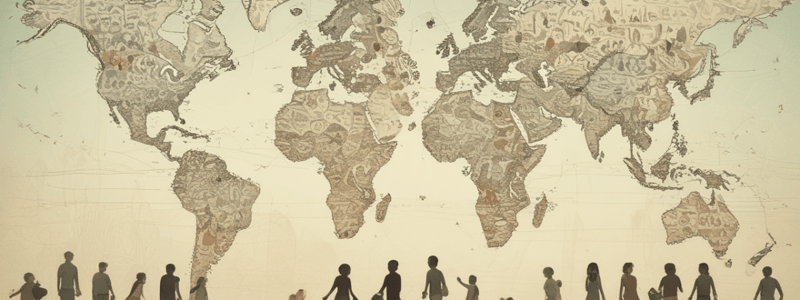Podcast
Questions and Answers
What is indicated by a constrictive pyramid in a population?
What is indicated by a constrictive pyramid in a population?
- Negative growth rate in a country
- High mortality rates in a specific age range
- Fewer young people than old people (correct)
- High birth rates and high death rates
What is the purpose of looking at age-specific mortality rates?
What is the purpose of looking at age-specific mortality rates?
- To compare mortality rates within a specific age range (correct)
- To determine the growth rate of a country
- To understand the overall mortality rate of a country
- To compare mortality rates between countries
What is the net migration rate?
What is the net migration rate?
- The number of people emigrating per 1,000 people in the country
- The number of people migrating to industrialized countries
- The number of people migrating within their own country
- The number of people entering the country minus the number of people leaving the country (correct)
What is internal migration?
What is internal migration?
What are the three main factors that contribute to the growth rate of a country?
What are the three main factors that contribute to the growth rate of a country?
What is the result of a country's population decreasing due to more deaths and emigrations than births and immigrations?
What is the result of a country's population decreasing due to more deaths and emigrations than births and immigrations?
What is the difference between emigration and immigration?
What is the difference between emigration and immigration?
What is a life table or mortality table?
What is a life table or mortality table?
Why is it important to consider all three factors of population growth?
Why is it important to consider all three factors of population growth?
What can be a result of internal migration in a country?
What can be a result of internal migration in a country?
What is generally true for countries with a constrictive pyramid?
What is generally true for countries with a constrictive pyramid?
Why is it useful to compare age-specific mortality rates?
Why is it useful to compare age-specific mortality rates?
What is the main reason for people to migrate from their country of birth to a new country?
What is the main reason for people to migrate from their country of birth to a new country?
What is the result of subtracting the number of deaths and emigrations from the number of births and immigrations?
What is the result of subtracting the number of deaths and emigrations from the number of births and immigrations?
What is the relationship between urbanization and internal migration?
What is the relationship between urbanization and internal migration?
What can be inferred about a country with a high mortality rate when comparing it to a country with a low mortality rate?
What can be inferred about a country with a high mortality rate when comparing it to a country with a low mortality rate?
What is the primary limitation of using an all-encompassing mortality rate to compare countries?
What is the primary limitation of using an all-encompassing mortality rate to compare countries?
What is the relationship between urbanization and internal migration?
What is the relationship between urbanization and internal migration?
What can be a consequence of a negative growth rate in a country?
What can be a consequence of a negative growth rate in a country?
What is the primary reason why people migrate from their country of birth to a new country?
What is the primary reason why people migrate from their country of birth to a new country?
Flashcards
Population dynamics
Population dynamics
The study of how a country's or region's population changes, considering factors that increase and decrease the population to determine the total growth rate.
Fertility
Fertility
The natural ability of humans to have babies, which adds to the population.
Birth rate
Birth rate
The number of births per 1,000 people in a year.
Total fertility rate
Total fertility rate
Signup and view all the flashcards
Migration
Migration
Signup and view all the flashcards
Immigration
Immigration
Signup and view all the flashcards
Emigration
Emigration
Signup and view all the flashcards
Mortality
Mortality
Signup and view all the flashcards
Mortality rate
Mortality rate
Signup and view all the flashcards
Life table
Life table
Signup and view all the flashcards
Population growth rate
Population growth rate
Signup and view all the flashcards
Negative growth rate
Negative growth rate
Signup and view all the flashcards
Internal migration
Internal migration
Signup and view all the flashcards
Urbanization
Urbanization
Signup and view all the flashcards
Study Notes
Population Dynamics
- Population dynamics studies how a country's or region's population changes, considering factors that increase and decrease the population to determine the total growth rate.
- Three factors contribute to the total growth rate: fertility, migration, and mortality.
Fertility
- Fertility refers to the natural ability of humans to have babies, which adds to the population.
- Birth rate is measured as the number of births per 1,000 people in a year.
- Total fertility rate is the number of children a woman is predicted to give birth to in her childbearing years.
- A total fertility rate of:
- Less than 2 decreases the population.
- Exactly 2 neither adds nor subtracts from the population.
- More than 2 increases the population.
- A total fertility rate of:
Migration
- Migration looks at the number of people moving into and out of countries, which changes the population of a specific country or region.
- Immigration is the movement of people into a country, increasing the population.
- Emigration is the movement of people out of a country, decreasing the population.
- Migration rates are measured per 1,000 people in the country.
Mortality
- Mortality refers to the fact that everyone eventually dies, decreasing the population.
- Mortality rates are measured as the number of deaths per 1,000 people in a year.
- Age-specific mortality rates provide a more accurate comparison between countries.
- A life table or mortality table shows the probability of death given a person's age.
Population Growth Rate
- The population growth rate is calculated by adding the number of births and immigrations, and subtracting the number of deaths and emigrations.
- A negative growth rate occurs when the number of deaths and emigrations exceeds the number of births and immigrations.
Additional Factors
- Internal migration refers to people moving within their own country, affecting the economics or cultures of a country.
- Urbanization is often a result of internal migration, as people move from rural to urban areas.
- Surveys and records are used to estimate population changes, as it is not possible to get an exact headcount of all people in the world.
Population Dynamics
- Population dynamics studies how a country's or region's population changes, considering factors that increase and decrease the population to determine the total growth rate.
- Three factors contribute to the total growth rate: fertility, migration, and mortality.
Fertility
- Fertility refers to the natural ability of humans to have babies, which adds to the population.
- Birth rate is measured as the number of births per 1,000 people in a year.
- Total fertility rate is the number of children a woman is predicted to give birth to in her childbearing years.
- A total fertility rate of:
- Less than 2 decreases the population.
- Exactly 2 neither adds nor subtracts from the population.
- More than 2 increases the population.
- A total fertility rate of:
Migration
- Migration looks at the number of people moving into and out of countries, which changes the population of a specific country or region.
- Immigration is the movement of people into a country, increasing the population.
- Emigration is the movement of people out of a country, decreasing the population.
- Migration rates are measured per 1,000 people in the country.
Mortality
- Mortality refers to the fact that everyone eventually dies, decreasing the population.
- Mortality rates are measured as the number of deaths per 1,000 people in a year.
- Age-specific mortality rates provide a more accurate comparison between countries.
- A life table or mortality table shows the probability of death given a person's age.
Population Growth Rate
- The population growth rate is calculated by adding the number of births and immigrations, and subtracting the number of deaths and emigrations.
- A negative growth rate occurs when the number of deaths and emigrations exceeds the number of births and immigrations.
Additional Factors
- Internal migration refers to people moving within their own country, affecting the economics or cultures of a country.
- Urbanization is often a result of internal migration, as people move from rural to urban areas.
- Surveys and records are used to estimate population changes, as it is not possible to get an exact headcount of all people in the world.
Population Dynamics
- Population dynamics studies how a country's or region's population changes, considering factors that increase and decrease the population to determine the total growth rate.
- Three factors contribute to the total growth rate: fertility, migration, and mortality.
Fertility
- Fertility refers to the natural ability of humans to have babies, which adds to the population.
- Birth rate is measured as the number of births per 1,000 people in a year.
- Total fertility rate is the number of children a woman is predicted to give birth to in her childbearing years.
- A total fertility rate of:
- Less than 2 decreases the population.
- Exactly 2 neither adds nor subtracts from the population.
- More than 2 increases the population.
- A total fertility rate of:
Migration
- Migration looks at the number of people moving into and out of countries, which changes the population of a specific country or region.
- Immigration is the movement of people into a country, increasing the population.
- Emigration is the movement of people out of a country, decreasing the population.
- Migration rates are measured per 1,000 people in the country.
Mortality
- Mortality refers to the fact that everyone eventually dies, decreasing the population.
- Mortality rates are measured as the number of deaths per 1,000 people in a year.
- Age-specific mortality rates provide a more accurate comparison between countries.
- A life table or mortality table shows the probability of death given a person's age.
Population Growth Rate
- The population growth rate is calculated by adding the number of births and immigrations, and subtracting the number of deaths and emigrations.
- A negative growth rate occurs when the number of deaths and emigrations exceeds the number of births and immigrations.
Additional Factors
- Internal migration refers to people moving within their own country, affecting the economics or cultures of a country.
- Urbanization is often a result of internal migration, as people move from rural to urban areas.
- Surveys and records are used to estimate population changes, as it is not possible to get an exact headcount of all people in the world.
Studying That Suits You
Use AI to generate personalized quizzes and flashcards to suit your learning preferences.




